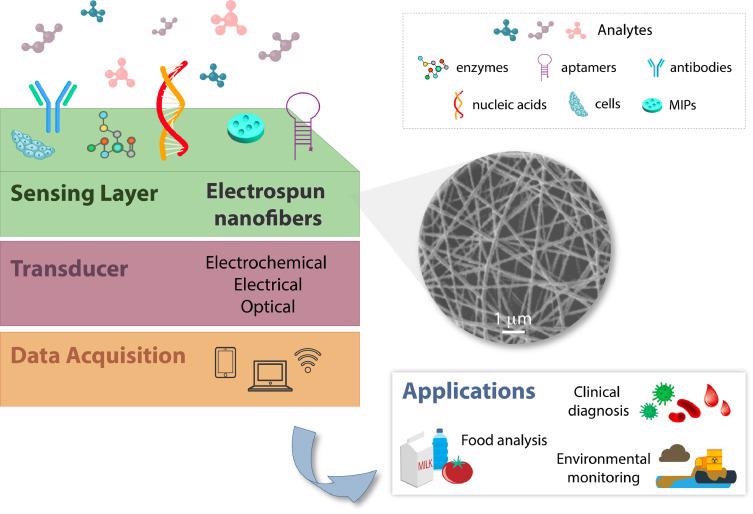Biosensors are increasingly being utilized in a range of disciplines, such as the agricultural and food industries. However, they also have applications in environmental control, medical technology, consumer goods and manufacturing liquid puncture label technology.

Image Credit: Mercante, L. A., Pavinatto, A., Pereira, T. S., Migliorini, F. L., dos Santos, D. M., & Correa, D. S. [2021]. Nanofibers interfaces for biosensing: design and applications. Sensors and Actuators Reports, [https://doi.org/10.1016/j.snr.2021.100048]
Recent research published in Sensors and Actuators Reports [1] by Mercante et al (2021) has found that Electrospun nanofibers (ENFs) are able to improve the performance of biosensor devices. This article will explore the aforementioned research study and briefly touch on both types of technology.
What are nanofibers and biosensors?
A biosensor is a small device that can detect the presence of a chemical or biological agent. The detection can be based on a specific nucleotide sequence in the molecule's protein structure or applied to a purely electronic circuit.
Biosensors used in medical, security and bio-medical applications are known as biosensing. They are based on active chemicals or small molecules generated by living organisms or directly by electrical current flowing through biological materials such as tissue or cells.
Nowadays, biosensors have applications in virtually every industry. Environmental monitoring detects environmental conditions such as gases, chemicals, water pollutants and even biological materials.
Biosensors could be used to provide the early discovery of illness and improve treatments by detecting biological threats within minutes of their manifestation or even respond to diseases in real-time.
Nanofibers, on the other hand, are a variety of fine-grip technology used in a range of electronic and mechanical applications. These fibers have been genetically modified to allow for the conduction of electrical current within their unique structure at a particular temperature range.
Typical applications include flexible solar cells for mobile electronics and biomedical implants and high-end audiophile components used in portable audio equipment and communications systems.
Why should we care about biosensor performance?
As biosensors become increasingly sophisticated, they will aid medical professionals in various ways that currently require tedious lab work. For example, when using an electrocardiogram (ECG), a biosensor activated by electroconvulsive therapy (ECT) could help identify patients who may be at risk for cardiovascular disease.
With improvements in biosensor performance, all other fields using this technology would also see improvements.
What does current academic research say?
In the study by Mercante et al 2021, the researchers review different strategies on increasing the performance of biosensors by modifying ENF surfaces and have modified nanofibers to be used as a material for biosensors.
In this case, nanofibers’ ability to pass currents means that they can help collect a larger quantity of various types of particles. This makes them attractive for applications in data processing and signal generation.
An ENF forms a complex surface structure with high free-energy peaks, which, in turn, can be customized for various purposes due to the large and open pore space, allowing it to attach specific binding proteins and bind to molecules of interest.
This makes it easier for the sensor to capture and identify compounds (like salt levels) based on how they bind to the fibers.
ENFs can also be used as scaffolds that support the growth of other materials and enable the immobilization of proteins and DNA.
These biomolecules can sense specific molecules and turn on a fluorescent signal if they detect them. In particular, when scientists want to create sensors to detect specific molecules, they usually use nanoscale materials, like carbon nanotubes, which encapsulate biomolecules, such as DNA.
However, fundamental investigations and further research need to be conducted to better understand the interaction between the nanofiber matrix and biomolecules, as well as the effect of electrospinning and immobilization parameters on the properties of biointerfaces.
References and Further Reading
- Mercante, L. A., Pavinatto, A., Pereira, T. S., Migliorini, F. L., dos Santos, D. M., & Correa, D. S. [2021]. Nanofibers interfaces for biosensing: design and applications. Sensors and Actuators Reports, [https://doi.org/10.1016/j.snr.2021.100048]
- Yahoo Finance [2021]. Global PPG Biosensors Market By Product, By Application, By Regional Outlook, Industry Analysis Report and Forecast, 2021 - 2027.https://finance.yahoo.com/news/global-ppg-biosensors-market-product-092000313.html
- Nogi, M., Karakawa, M., Komoda, N., Yagyu, H., & Nge, T. T. (2015). Transparent conductive nanofiber paper for foldable solar cells. Scientific reports, 5(1), 1-7. [DOI.org 10.1038/srep17254]
Disclaimer: The views expressed here are those of the author expressed in their private capacity and do not necessarily represent the views of AZoM.com Limited T/A AZoNetwork the owner and operator of this website. This disclaimer forms part of the Terms and conditions of use of this website.